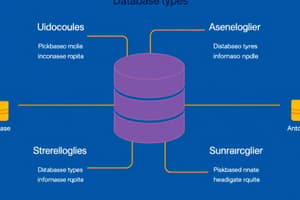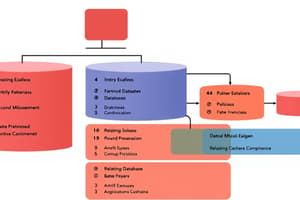Podcast
Questions and Answers
Which of the following is NOT a characteristic of the evolution of data storage in external memory?
Which of the following is NOT a characteristic of the evolution of data storage in external memory?
- Increasing data complexity
- Ensuring the data is always readily available for access
- Improving the equipment for collecting, storing, transmitting, and processing data
- Minimizing the cost of storage and retrieval (correct)
What distinguishes a relational database from earlier database generations?
What distinguishes a relational database from earlier database generations?
- Hierarchical structure of data storage
- Ability to handle complex data structures
- Use of tables and relationships between them (correct)
- Support for object-oriented programming concepts
Which type of database is best suited for storing and querying data with complex relationships, such as social networks or knowledge graphs?
Which type of database is best suited for storing and querying data with complex relationships, such as social networks or knowledge graphs?
- Object-oriented database
- Hierarchical database
- Relational database
- Graph database (correct)
In the context of the provided content, what does the 'owner node' refer to?
In the context of the provided content, what does the 'owner node' refer to?
Which of the following is a difference between a network database and a graph database?
Which of the following is a difference between a network database and a graph database?
In the example provided, what is the owner node in the network database?
In the example provided, what is the owner node in the network database?
Which of the following is an example of a database technology that emerged in the third generation of databases?
Which of the following is an example of a database technology that emerged in the third generation of databases?
What is the primary advantage of a distributed database over a centralized database?
What is the primary advantage of a distributed database over a centralized database?
What is the purpose of the correspondence between a row in the Students table and a specific node in the graph, as described in the content?
What is the purpose of the correspondence between a row in the Students table and a specific node in the graph, as described in the content?
Which of the following is NOT an example of an advanced database type mentioned in the content?
Which of the following is NOT an example of an advanced database type mentioned in the content?
Which of the following best describes the relationship between data, data structure, and data organizing in the provided context?
Which of the following best describes the relationship between data, data structure, and data organizing in the provided context?
Based on the provided examples, what is a key characteristic of a file system compared to a database?
Based on the provided examples, what is a key characteristic of a file system compared to a database?
What is an example of a data structure that can be used to represent an employee record in a file system?
What is an example of a data structure that can be used to represent an employee record in a file system?
In the context of databases, what is the significance of the 'create table' statement?
In the context of databases, what is the significance of the 'create table' statement?
Which of the following describes a 'feature' as defined in the content?
Which of the following describes a 'feature' as defined in the content?
What is the relationship between a 'feature' and a 'family of features'?
What is the relationship between a 'feature' and a 'family of features'?
Which of the following best describes a 'data collection' as defined in the context?
Which of the following best describes a 'data collection' as defined in the context?
What is the primary difference between a database and a file system regarding data retrieval?
What is the primary difference between a database and a file system regarding data retrieval?
Which of the following is NOT a distinct element within a database's structure?
Which of the following is NOT a distinct element within a database's structure?
Which of the following statements about data organizing and data structures is TRUE?
Which of the following statements about data organizing and data structures is TRUE?
Which is NOT a characteristic of Big Data?
Which is NOT a characteristic of Big Data?
What is the primary objective of a database?
What is the primary objective of a database?
According to the course structure, what are the core topics covered?
According to the course structure, what are the core topics covered?
What is the primary focus of the 'Data' section in the course?
What is the primary focus of the 'Data' section in the course?
What are the two main components of the final grade in this course?
What are the two main components of the final grade in this course?
Which of the provided textbooks is written by a professor from the teaching staff?
Which of the provided textbooks is written by a professor from the teaching staff?
Which of the following is NOT a listed topic in the 'Course Structure' section?
Which of the following is NOT a listed topic in the 'Course Structure' section?
What is the minimum passing grade required for the seminar work and the final exam?
What is the minimum passing grade required for the seminar work and the final exam?
What is the weight of the project in the seminar work?
What is the weight of the project in the seminar work?
What is the weight of the SQL exercises in the final exam?
What is the weight of the SQL exercises in the final exam?
Flashcards
Data Storage Evolution
Data Storage Evolution
The process of advancing how data is stored over time, from simple files to complex databases.
External Memory
External Memory
The part of a computer where data is stored persistently, as opposed to internal memory, which is temporary.
Hierarchical DB
Hierarchical DB
The first generation of databases, organizing data in a tree-like structure.
Relational DB
Relational DB
Signup and view all the flashcards
Object-oriented DB
Object-oriented DB
Signup and view all the flashcards
Distributed DB
Distributed DB
Signup and view all the flashcards
Graph DB
Graph DB
Signup and view all the flashcards
Centralized DB
Centralized DB
Signup and view all the flashcards
Network DB
Network DB
Signup and view all the flashcards
Key-Value Pairs
Key-Value Pairs
Signup and view all the flashcards
Seminar Work Weight
Seminar Work Weight
Signup and view all the flashcards
Re-examination Policy
Re-examination Policy
Signup and view all the flashcards
Database Definition
Database Definition
Signup and view all the flashcards
The 17 V’s of Big Data
The 17 V’s of Big Data
Signup and view all the flashcards
Relational Databases
Relational Databases
Signup and view all the flashcards
SQL Language
SQL Language
Signup and view all the flashcards
Queries Optimization
Queries Optimization
Signup and view all the flashcards
Indexing
Indexing
Signup and view all the flashcards
Big Data Characteristics
Big Data Characteristics
Signup and view all the flashcards
Knowledge vs Insight
Knowledge vs Insight
Signup and view all the flashcards
Graph DB Representation
Graph DB Representation
Signup and view all the flashcards
Data Structure
Data Structure
Signup and view all the flashcards
Files
Files
Signup and view all the flashcards
Database
Database
Signup and view all the flashcards
Feature (Attribute)
Feature (Attribute)
Signup and view all the flashcards
Family of Features
Family of Features
Signup and view all the flashcards
Data Collection (Entity)
Data Collection (Entity)
Signup and view all the flashcards
Range of Values
Range of Values
Signup and view all the flashcards
DB vs. File System
DB vs. File System
Signup and view all the flashcards
Oracle Database
Oracle Database
Signup and view all the flashcards
Study Notes
Course Information
- Course title: Databases Course 1
- Instructor: Anda Belciu, PhD
- Email: [email protected]
- Office: 2017 C
- Additional resources: bd.ase.ro, online.ase.ro
Course Examination
- Examination weighting:
- 50% seminar work (30% project, mandatory, 20% activity)
- 50% exam (multiple choice questions + SQL exercises)
- Minimum mark for both seminar and exam sections: 5
- Re-examination: allowed even if seminar grade is below 5
- Oracle Academy online courses (deadline: 16th December 2024) + final exam (week 12): bonus for seminar
Teaching Staff
- Anda Belciu, PhD (groups 1072, 1076)
- Laurențiu Dincă, PhD-candidate (groups 1074, 1075)
- Alin Văduva, PhD-candidate (group 1073)
Bibliography
- C.J. Date, An introduction to database systems, Addison Wesley, 2004, USA.
- R. Elmasri, S. Navathe, Fundamentals of database systems, 7th edition, Pearson, 2016, USA.
- I. Lungu et al., Baze de date. Organizare, proiectare și implementare (Databases. Organization, design and implementation), ASE Publishing House, Second Edition, 2015, Romania.
- A. Belciu, Introduction to Databases, ASE Publishing House, 2016, Romania.
Course Structure
- Database theory
- Data organization in external memory
- Relational databases
- SQL language
- Database development methodology
- Indexing
- Cluster management in relational databases
- Query optimization
- NoSQL databases and other database types
Data, Information, Knowledge, Insight, and Wisdom
- Example:
- Information: Employee Smith has 40 customers.
- Knowledge: Employee Smith has 40 customers, while other employees average 20 customers.
- Insight: 40 vs 20 customers.
- Wisdom: Employee Smith will have a salary raise.
Big Data Characteristics
- Volume: huge
- Velocity: high speed
- Variety: unstructured
- Variability: data meaning changes constantly
- Veracity: uncertainty of data
- Visualization: charts and graphs
- Value: adds value to the business
Database Definitions
- Database (DB): organized, coherent, structured data, with minimum redundancy and control, accessible to multiple users efficiently.
- Database: a set of interrelated data and their descriptions, including links between data items.
Database Evolution
- Data storage in computers: initially in internal memory (temporary) and then external memory (permanent).
- Improvements in external storage: faster and more efficient access to data, larger data storage capacity, improved data complexity handling, more sophisticated data collection, storage, transmission, and processing tools.
- Databases evolve from simple file systems to integrated systems considering relationships between data and related applications.
Database Generations
- First generation: hierarchical and network databases (until late 70s)
- Second generation: relational databases (late 70s to present)
- Third generation: object-oriented databases (late 80s to present)
- Advanced databases: spatial, multimedia, mobile, NoSQL databases (distributed, cloud, graph)
- Distributed databases vs. centralized databases
- Network databases vs. graph databases
Network Database Example
- Set type in network database structure: owner node (DEPARTMENT) and member node (PERSON).
- Example: department 100: IT, popa anda, moşiloi, 22
- Person 010: petre ion, eminescu, 10
Graph Database Representation
- Correspondence between table rows and graph nodes, displaying properties and values through key-value pairs.
Data Structure Types: Files and Databases
- Files: Data stored in programs (e.g. C example).
- Data is in main file (e.g., .txt).
- Databases: Data stored in database dictionary (e.g. oracle example).
- Data kept separately in a disk file (e.g., .db).
Database Components
- Database structure: files, records, fields, values
- Range of values: possible values for a feature in a system
- Feature (attribute): defining characteristic of an entity
- Family of features: characteristics describing an entity
- Data collection (entity): common characteristics used to derive data connections/meanings
Studying That Suits You
Use AI to generate personalized quizzes and flashcards to suit your learning preferences.




